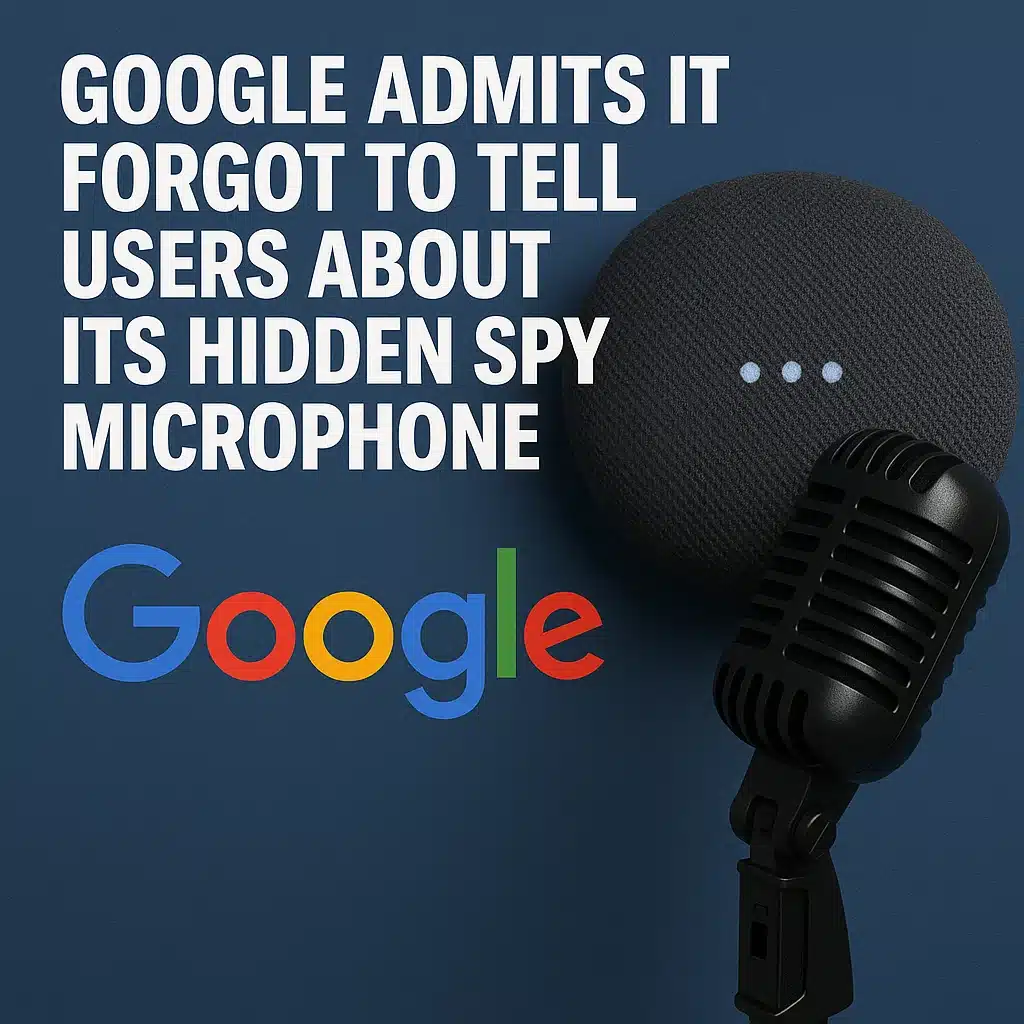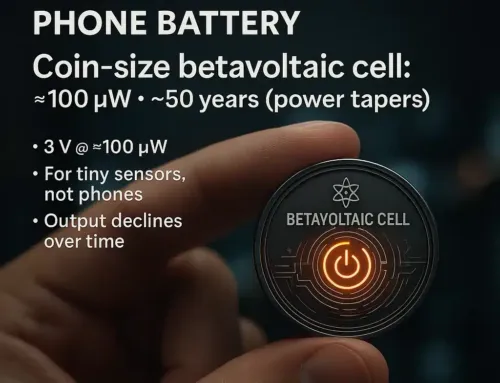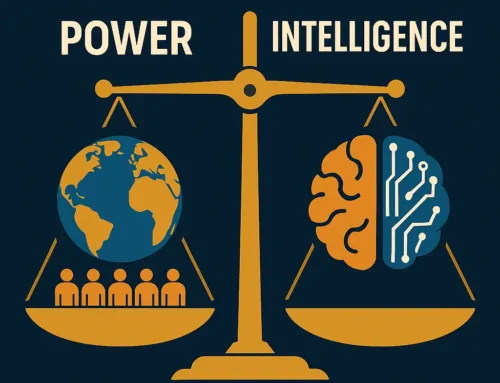
Approx. read time: 7.5 min.
Post: Google admits it forgot to tell users about its hidden spy microphone
Google’s Hidden Microphone: A “Mistake” or a Glimpse Into a Surveillance Future?
In 2019, Google quietly admitted it had forgotten to disclose a built-in microphone in its Nest Secure home security system—a device marketed to protect privacy, not compromise it. The microphone had been there all along. It just wasn’t listed in the product’s specifications. Only after Google rolled out a software update allowing Nest Secure’s central hub to use Google Assistant—thereby requiring a microphone—did users start asking questions.
Google’s response? An unconvincing shrug: “The on-device microphone was never intended to be a secret and should have been listed in the tech specs. That was an error on our part.” But in an age where trust in tech giants is already thin, the implications were anything but minor. Was this a simple oversight or something far more calculated?
What Happened?
Google launched Nest Secure in 2017 as a smart home security system that integrates motion detectors, contact sensors, and security cameras through a centralized hub called the Nest Guard. The Nest Guard is the brain of the system—arming and disarming the network, connecting to mobile apps, and serving as the interface between the home and the user.
For two years, Google’s published product documentation made no mention of any audio recording capability or built-in microphone. That changed in February 2019, when Google pushed an update enabling Google Assistant on the Nest Guard hub. This update meant users could now interact with the device via voice, like they would with a smart speaker. Which, of course, requires a microphone.
The surprise wasn’t just that Google added Assistant functionality. It was that a microphone had always been inside the Nest Guard, quietly waiting.
Google’s Explanation
Google’s official statement aimed to defuse the uproar: “The microphone has never been on and is only activated when users specifically enable the option.” They added that the microphone was originally intended to support future features like sound-based security alerts (e.g., glass breaking).
The company updated the Nest Secure tech specs to reflect the presence of the microphone—but only after the fact. The original listings and packaging made no mention of it. You can still find screenshots online showing the earlier version of the documentation, which omits any mention of audio hardware source: Business Insider.
Why It Matters
The issue here isn’t just technical—it’s ethical. Inserting undisclosed microphones into devices designed for private spaces like bedrooms and living rooms is a serious breach of consumer trust. Even if the mic was never active, the fact that it existed without user knowledge changes the calculus of privacy.
Jake Williams, a former NSA hacker and founder of Rendition Infosec, told Business Insider that the omission was “unbelievable.” He added, “Even if Google didn’t intend to keep this a secret, consumers should expect full transparency when they place an internet-connected device in their home.”
The fact that this wasn’t disclosed at launch—and only came to light once a voice feature was added—fuels a broader anxiety: Big Tech keeps testing the limits of how much access it can gain into users’ lives without their informed consent.
A Pattern of “Accidents”
This isn’t the first time Google’s approach to user data has come under fire. The company has a documented history of controversial data practices:
- Street View Wi-Fi Data Collection: Between 2007 and 2010, Google’s Street View cars weren’t just taking photos—they were also collecting data from unencrypted Wi-Fi networks. Google later admitted that its cars had captured emails, passwords, and browsing data from households around the world source: Guardian.
- Free WiFi Kiosks in NYC: Sidewalk Labs, a Google-affiliated company, installed public WiFi kiosks across New York City. Privacy groups later raised concerns about whether those kiosks were tracking users’ locations or usage patterns without informed consent source: NY Times.
- Facial Recognition: In 2019, Google employees were caught tricking people—especially homeless individuals—into letting them scan their faces as part of a project to improve facial recognition tech on Pixel phones source: New York Daily News.
Add to that Project Nightingale (a secret initiative to collect health data on millions of Americans) and Google’s internal “Selfish Ledger” video—an internal concept video suggesting that Google could one day guide users’ decisions based on collected data—and a pattern emerges.
The “Selfish Ledger” Vision
In 2018, The Verge leaked an internal Google video titled “The Selfish Ledger.” It presented a speculative concept: Google could eventually use behavioral data to guide users toward life choices that aligned with “Google’s values” source: The Verge.
The video, while never intended for public release, was deeply Orwellian. It described a system in which every user interaction feeds into a central ledger—a digital profile that grows more detailed with time. Over the years, Google would begin suggesting behaviors, purchases, and even goals, based on the data it collects.
Google later distanced itself from the video, claiming it was simply a thought experiment. But to many, the fact that such a concept even existed internally was a red flag.
A Global Double Standard?
While American politicians and media outlets often focus on Chinese tech companies like Huawei—alleging (but not always proving) state-sponsored espionage—there’s far less outcry over the data abuses of domestic giants like Google.
For Huawei, the allegations of surveillance have led to bans, sanctions, and massive public scrutiny. But Huawei’s supposed surveillance is often targeted at government and industrial espionage, not individual users in their homes. Google, on the other hand, builds systems that live inside your house, listens to your conversations, and mines your behavioral data to optimize ad targeting, product design, and potentially social influence.
If there’s a difference between the two approaches, it’s mostly strategic—not ethical. Chinese surveillance efforts may be government-directed and targeted. Google’s surveillance is corporate-driven and omnidirectional.
Consent Theater
Google’s defense—that the microphone was “never on” unless users enabled it—leans on the idea of consent. But consent is only valid if users are fully informed. Hiding the presence of a microphone and then asking users to “enable” it later doesn’t cut it. That’s not meaningful consent—it’s a bait-and-switch.
Moreover, the idea that the mic was “off” until activation is hard to independently verify. As security expert Eva Galperin of the Electronic Frontier Foundation (EFF) pointed out, “It’s time to stop treating microphones as benign or neutral technology. They are surveillance devices—full stop.”
The Larger Problem: Trust
This Nest microphone debacle is about more than just one device. It’s a symptom of a wider disease: the normalization of surveillance in the name of convenience. From smart speakers to fitness trackers, our homes are filled with devices that collect data. And too often, we take tech companies at their word that our data is safe.
Google’s apology doesn’t erase the fact that it installed an undisclosed listening device in homes across the country. Nor does it address the growing mistrust of how Big Tech defines transparency.
The Nest incident also highlights the inadequacy of current privacy laws. In the U.S., there’s no comprehensive federal data privacy legislation that requires tech companies to disclose every sensor or method of data collection in their devices. Europe’s GDPR goes much further, but enforcement is still spotty when it comes to opaque hardware practices.
Where We Go From Here
The lesson from the Nest microphone scandal is clear: we can’t assume that tech companies will tell us the whole truth. Whether by design or neglect, undisclosed features—especially ones capable of recording audio or video—should be treated as potential breaches of trust until proven otherwise.
Consumers must demand greater transparency. Regulators must catch up with the pace of surveillance tech. And companies like Google need to be held accountable not just when they get caught—but preemptively, through tougher laws and real oversight.
Because when a company puts a microphone in your home without telling you, it’s not just a “mistake.” It’s a signal.
A signal that someone, somewhere, is always listening.
Sources:
- Business Insider. “Google says it forgot to disclose the Nest Secure has a microphone”
- The Verge. “Google’s Selfish Ledger video reveals a disturbing future of data collection”
- The Guardian. “Google admits its Street View cars collected emails and passwords”
- New York Times. “Wi-Fi Kiosks Are Coming to NYC”
- New York Daily News. “Google used contractors to scan faces, targeting homeless”
- Electronic Frontier Foundation. “Smart Speakers and Surveillance”









